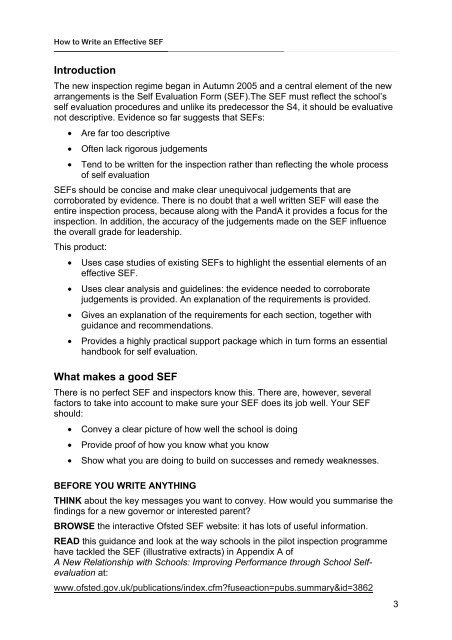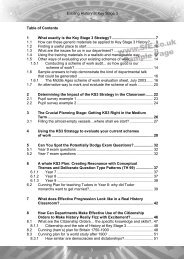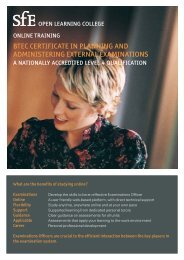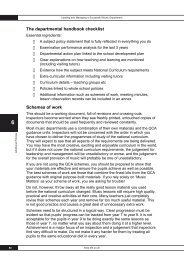How to Write an Effective SEF - SfE
How to Write an Effective SEF - SfE
How to Write an Effective SEF - SfE
Create successful ePaper yourself
Turn your PDF publications into a flip-book with our unique Google optimized e-Paper software.
<strong>How</strong> <strong>to</strong> <strong>Write</strong> <strong>an</strong> <strong>Effective</strong> <strong>SEF</strong><br />
Introduction<br />
The new inspection regime beg<strong>an</strong> in Autumn 2005 <strong>an</strong>d a central element of the new<br />
arr<strong>an</strong>gements is the Self Evaluation Form (<strong>SEF</strong>).The <strong>SEF</strong> must reflect the school’s<br />
self evaluation procedures <strong>an</strong>d unlike its predecessor the S4, it should be evaluative<br />
not descriptive. Evidence so far suggests that <strong>SEF</strong>s:<br />
• Are far <strong>to</strong>o descriptive<br />
• Often lack rigorous judgements<br />
• Tend <strong>to</strong> be written for the inspection rather th<strong>an</strong> reflecting the whole process<br />
of self evaluation<br />
<strong>SEF</strong>s should be concise <strong>an</strong>d make clear unequivocal judgements that are<br />
corroborated by evidence. There is no doubt that a well written <strong>SEF</strong> will ease the<br />
entire inspection process, because along with the P<strong>an</strong>dA it provides a focus for the<br />
inspection. In addition, the accuracy of the judgements made on the <strong>SEF</strong> influence<br />
the overall grade for leadership.<br />
This product:<br />
• Uses case studies of existing <strong>SEF</strong>s <strong>to</strong> highlight the essential elements of <strong>an</strong><br />
effective <strong>SEF</strong>.<br />
• Uses clear <strong>an</strong>alysis <strong>an</strong>d guidelines: the evidence needed <strong>to</strong> corroborate<br />
judgements is provided. An expl<strong>an</strong>ation of the requirements is provided.<br />
• Gives <strong>an</strong> expl<strong>an</strong>ation of the requirements for each section, <strong>to</strong>gether with<br />
guid<strong>an</strong>ce <strong>an</strong>d recommendations.<br />
• Provides a highly practical support package which in turn forms <strong>an</strong> essential<br />
h<strong>an</strong>dbook for self evaluation.<br />
What makes a good <strong>SEF</strong><br />
There is no perfect <strong>SEF</strong> <strong>an</strong>d inspec<strong>to</strong>rs know this. There are, however, several<br />
fac<strong>to</strong>rs <strong>to</strong> take in<strong>to</strong> account <strong>to</strong> make sure your <strong>SEF</strong> does its job well. Your <strong>SEF</strong><br />
should:<br />
• Convey a clear picture of how well the school is doing<br />
• Provide proof of how you know what you know<br />
• Show what you are doing <strong>to</strong> build on successes <strong>an</strong>d remedy weaknesses.<br />
BEFORE YOU WRITE ANYTHING<br />
THINK about the key messages you w<strong>an</strong>t <strong>to</strong> convey. <strong>How</strong> would you summarise the<br />
findings for a new governor or interested parent?<br />
BROWSE the interactive Ofsted <strong>SEF</strong> website: it has lots of useful information.<br />
READ this guid<strong>an</strong>ce <strong>an</strong>d look at the way schools in the pilot inspection programme<br />
have tackled the <strong>SEF</strong> (illustrative extracts) in Appendix A of<br />
A New Relationship with Schools: Improving Perform<strong>an</strong>ce through School Selfevaluation<br />
at:<br />
www.ofsted.gov.uk/publications/index.cfm?fuseaction=pubs.summary&id=3862<br />
3
<strong>How</strong> <strong>to</strong> <strong>Write</strong> <strong>an</strong> <strong>Effective</strong> <strong>SEF</strong><br />
What <strong>to</strong> <strong>Write</strong> – Ofsted Guid<strong>an</strong>ce<br />
The <strong>SEF</strong> includes some introduc<strong>to</strong>ry guid<strong>an</strong>ce by Ofsted. Ensure you read this first<br />
<strong>an</strong>d the accomp<strong>an</strong>ying section guid<strong>an</strong>ce given before writing. It lists the three<br />
sections you need <strong>to</strong> complete, when <strong>to</strong> do so, who it is for <strong>an</strong>d provides a brief<br />
account of how <strong>to</strong> fill in the form.<br />
Other General Points <strong>to</strong> Note<br />
• Acronyms should only be used once they have been explained, as they may<br />
not be readily unders<strong>to</strong>od by others.<br />
• Referencing <strong>to</strong> pertinent evidence sources/documents is always difficult <strong>to</strong><br />
achieve when trying <strong>to</strong> produce a concise evaluation. One way which c<strong>an</strong><br />
work well is <strong>to</strong> list at the beginning or end of each section (or indeed at the<br />
beginning of the <strong>SEF</strong>), the evidence sources, code them <strong>an</strong>d apply the code at<br />
the relev<strong>an</strong>t positions throughout the sections.<br />
Eg Attainment on entry <strong>an</strong>alysis document (AOEA)<br />
• Whilst it is helpful <strong>to</strong> use the <strong>SEF</strong> as a notebook, ie putting bullet pointed two<br />
<strong>an</strong>d three word phrases in each section as a starting point, be sure that it does<br />
not s<strong>to</strong>p here.<br />
• Beware of raising new points in a long section, if they would more naturally fit<br />
in other sections. Cross referencing is the <strong>an</strong>swer.<br />
• Ensure that comments made are evaluative.<br />
• Where good <strong>an</strong>d outst<strong>an</strong>ding judgements are made, ensure they are backed<br />
up with clear evidence that such a provision impacts in a good or outst<strong>an</strong>ding<br />
way on the students’ achievement.<br />
• Tell the truth, don’t try <strong>an</strong>d cover up, within reason. It soon becomes apparent<br />
when comparing the P<strong>an</strong>dA <strong>an</strong>d the <strong>SEF</strong> where the problems are likely <strong>to</strong> be.<br />
• Check contents against headings, <strong>to</strong> ensure comments are in the correct<br />
section.<br />
• Avoid implying or ‘crystal ball gazing’. Give only subst<strong>an</strong>tiated facts rather th<strong>an</strong><br />
what might happen.<br />
• Where possible, when using the term ‘outst<strong>an</strong>ding’, try <strong>an</strong>d give impartial<br />
evidence sources which have evaluated the provision as such. An outst<strong>an</strong>ding<br />
claim will usually ensure closer scrutiny of this feature by Ofsted.<br />
• Try not <strong>to</strong> run out of steam by section 5, as sections 5 <strong>to</strong> 7 are very import<strong>an</strong>t<br />
yet are often the least well covered. Sections 1 <strong>an</strong>d 2 are often <strong>to</strong>o elaborate<br />
at the expense of the latter ones.<br />
6
<strong>How</strong> <strong>to</strong> <strong>Write</strong> <strong>an</strong> <strong>Effective</strong> <strong>SEF</strong><br />
1. Characteristics of Your School<br />
(Found in Part A: Self-evaluation)<br />
What are the main characteristics of your school?<br />
Drawing on Section B <strong>an</strong>d C of this form <strong>an</strong>d other relev<strong>an</strong>t data, write a brief<br />
description of its features.<br />
(Please note that this is <strong>an</strong> opportunity for a brief summary of the main<br />
characteristics of the school <strong>an</strong>d it is not necessary <strong>to</strong> repeat tables of data.)<br />
1a: Please outline the main characteristics of the learners, including:<br />
• Their attainment on entry <strong>an</strong>d how you know this<br />
• Their social <strong>an</strong>d economic backgrounds, indicating the level of<br />
prosperity or deprivation<br />
Points <strong>to</strong> note:<br />
• Good clear reference of attainment on entry is needed <strong>to</strong> ensure the reader<br />
knows how attainment compares nationally <strong>an</strong>d the source of this<br />
information. (This format of comparison against the national figure should be<br />
maintained through evaluations on SEN <strong>an</strong>d FSM). NFER/CATS/KS2<br />
evidence is also needed when read in conjunction with this statement.<br />
• The contextualised P<strong>an</strong>dA <strong>an</strong>d inspec<strong>to</strong>rs will refer mostly <strong>to</strong> KS2 data in<br />
relation <strong>to</strong> attainment on entry in Year 7. Hence, <strong>an</strong> overall statement of what<br />
this data indicates should be given. Any differences <strong>to</strong> this indicated in<br />
practice should be evaluated, eg indications about reading ages. <strong>How</strong>ever,<br />
there should be a statement, preferably at the beginning, saying what<br />
attainment on entry is, with evaluated reasons rather th<strong>an</strong> descriptions.<br />
• Do not give tables of KS2 grades on entry: they are not needed. Brief basic<br />
evaluation is all that is required. Give average KS2 results with comment on<br />
how this compares <strong>to</strong> the national average, rather th<strong>an</strong> listing, for example,<br />
each year group per subject.<br />
• FSM, SEN, statemented learners. For each of these indica<strong>to</strong>rs give a<br />
description of whether the school identifies this as broadly average, generally<br />
above average etc.<br />
• Define the attainment on entry st<strong>an</strong>dards according <strong>to</strong> the new Ofsted criteria<br />
which for st<strong>an</strong>dards only are:<br />
Grade 1: Exceptionally <strong>an</strong>d consistently high<br />
Grade 2: Generally above average with none signific<strong>an</strong>tly below average<br />
Grade 3: Broadly average<br />
Grade 4: Exceptionally low<br />
• An overall judgement on whether the cohort is average or below average in<br />
each of the key stages would be helpful. (Evidence for this will be available<br />
in the Contexualised Value Added P<strong>an</strong>dA).<br />
8
<strong>How</strong> <strong>to</strong> <strong>Write</strong> <strong>an</strong> <strong>Effective</strong> <strong>SEF</strong><br />
1b: Please summarise briefly your distinctive aims <strong>an</strong>d describe <strong>an</strong>y special<br />
features of your school, for example:<br />
• Whether you intend <strong>to</strong> become a specialist school, or school with special<br />
status, <strong>an</strong>d if it is one already, the main ch<strong>an</strong>ges that have occurred because<br />
of this<br />
• Whether you are a school with a religious character<br />
• Any special units, additional community services or extended provision<br />
• Signific<strong>an</strong>t partnerships with other providers or agencies (such as shared<br />
arr<strong>an</strong>gements)<br />
Points <strong>to</strong> note:<br />
• Reference <strong>to</strong> initial teacher training carried by the school whether SCITT <strong>an</strong>d<br />
GTP training<br />
• Evaluate where possible how the distinctive aims <strong>an</strong>d special features<br />
impact upon students noted.<br />
• College links eg make explicit how employers’ needs are met through<br />
developing work-related skills.<br />
• Evaluate the provision of org<strong>an</strong>isations such as the Any<strong>to</strong>wn LEA Music<br />
School being resident in your school. Where possible, evaluate the<br />
outcomes in terms of impact upon the students.<br />
• Evaluate what effect the specialist status has had on st<strong>an</strong>dards <strong>an</strong>d<br />
achievement made in the school.<br />
• Are there <strong>an</strong>y links from which the school derives benefit rather th<strong>an</strong> as a<br />
supporter for other schools?<br />
Example 1<br />
Amarillo became a specialist Sports College in 2001. Our sports development pl<strong>an</strong><br />
reflects our school aim <strong>to</strong> encourage students <strong>to</strong> participate in activities which<br />
present new challenges <strong>an</strong>d help them <strong>to</strong> develop confidence <strong>an</strong>d self-reli<strong>an</strong>ce. This<br />
has enh<strong>an</strong>ced our community partnerships which are very import<strong>an</strong>t <strong>to</strong> us,<br />
particularly those with local primary schools <strong>an</strong>d with sports clubs. For the last two<br />
years Amarillo has provided a base for a School Sports Coordina<strong>to</strong>r partnership<br />
involving four partner secondary schools <strong>an</strong>d each local cluster of primary schools.<br />
Amarillo has a joint use Sports Centre on site. Facilities at the Centre have been<br />
much improved in the last three years through a subst<strong>an</strong>tial Lottery Fund gr<strong>an</strong>t made<br />
following our successful bid for Sports College status. We have also benefited from<br />
additional funding from the LTA <strong>to</strong> support tennis development.<br />
Partnership working with secondary schools is <strong>an</strong> especially strong feature of our<br />
school development. The secondary heads meet regularly <strong>an</strong>d participate in the local<br />
Learning Forum, with local partners from colleges <strong>an</strong>d training org<strong>an</strong>isations.<br />
Comment: Clear evaluative statements<br />
11








